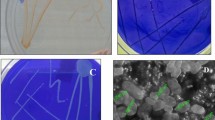Abstract
The metabolism of monohalophenols by Penicillium simplicissimum SK9117, isolated from a sewage plant was investigated. In submerged cultures, 3-, 4-chlorophenol, and 4-bromophenol were metabolized in the presence of phenol. 3-Chlorophenol was transformed to chlorohydroquinone, 4-chlorocatechol, 4-chloro-1,2,3-trihydroxybenzene, and 5-chloro-1,2,3-trihydroxybenzene. With 4-chlorophenol only 4-chlorocatechol was observed as transient product. A release of chloride ions was not observed. Whereas monobromo-, and monochlorophenols could not support growth as sole carbon and energy source, growth and release of fluoride ions were observed with monofluorophenols as substrates. In presence of phenol, the degradation of all monofluorophenols was enhanced. Substrate and cosubstrate disappeared simultaneously. 3-Fluorophenol and 4-fluorophenol were completely mineralized as shown by the equimolar release of fluoride ions.
Similar content being viewed by others
References
Anselmo AM & Novais JM (1984) Isolation and selection of phenoldegrading microorganisms from an industrial effluent. Biotechnol. Lett. 6: 601–606
Anselmo AM, Mateus M, Cabral JMS & Novais JM (1985) Degradation of phenol by immobilized cells of Fusarium flocciferum. Biotechnol. Lett. 7: 889–894
Gaal A & Neujahr HY (1979) Metabolism of phenol and resorcinol in Trichosporon cutaneum. J. Bacteriol. 137: 13–21
Hasegawa Y, Okamoto T, Obata H & Tokuyama T (1990) Utilization of aromatic compounds by Trichosporon cutaneum KUY-6A. J. Ferment. Bioeng. 69: 122–124
Hofmann KH & Schauer F (1988) Utilization of phenol by hydrocarbon assimilating yeasts. Antonie van Leeuvenhoek 54: 179–188
Hofrichter M, Günther T & Fritsche W (1992) Metabolism of halo-and nitroaromatic compounds by fungi of contaminated soils. In: Preprints International Symposium Soil Decontamination Using Biological Processes (pp 305–312). DECHEMA, Karlsruhe.
Hofrichter M, Günther T & Fritsche W (1993) Metabolism of phenol, chloro- and nitrophenols by the Penicillium strain Bi 7/2 isolated from a contaminated soil. Biodegradation 3: 415–421
Hofrichter M & Scheibner K (1993) Utilization of aromatic compounds by the Penicillium Strain Bi7/2. J. Basic. Microbiol. 33: 227–232
Hofrichter M, Bublitz F & Fritsche W (1994) Unspecific degradation of halogenated phenols by the soil fungusPenicillium frequentans Bi 7/2. J. Basic. Microbiol. 34: 163–172
Jong E, Beuling EE, Zwan P & Bont JAM (1990) Degradation of veratryl alcohol by Penicillium simplicissimum. Appl. Microbiol. Biotechnol. 34: 420–425
Kaufman DD, Plimmer JR & Klingebiel UI (1973) Microbial oxidation of 4-chloroaniline. J. Agr. Food. Chem. 21: 127–132
Krug M, Ziegler H & Straube G. (1985) Degradation of phenolic compounds by the yeast Candida tropicalis HP 15. J. Basic Microbiol. 25: 103–110
Neujahr HY & Varga JM (1970) Degradation of phenols by intact cells and cell-free preparations of Trichosporon cutaneum. Eur. J. Biochem. 13: 37–44
Patel TR, Hameed N & Martin AM (1990) Initial steps of phloroglucinol metabolism in Penicillium simplicissimum. Arch. Microbiol. 153: 438–443
Pitt JI (1979) The genus Penicillium and its teleomorphic states Eupenicillium and Talaromyces. (pp 276–280) Academic Press, London
Polnisch E, Kneifel H, Franzke H & Hofmann HH (1992) Degradation and dehalogenation of monochlorophenols by the phenolassimilating yeast Candida maltosa. Biodegradation 2: 193–199
Scow KM, Li D, Manilal VB & Alexander M (1990) Mineralization of organic compounds at low concentrations by filamentous fungi. Mycol. Res. 94: 793–798
Walker N (1973) Metabolism of chlorphenols by Rhodotorula glutinis. Soil Biol. Biochem. 5: 525–530
Wedding RT & Kentrick JD (1959) Toxicity of N-methyl-dithiocarbamate and methylisothiocanat to Rhizoctonia solani. Phytopathol. 49: 557–561
Author information
Authors and Affiliations
Rights and permissions
About this article
Cite this article
Marr, J., Kremer, S., Sterner, O. et al. Transformation and mineralization of halophenols by Penicillium simplicissimum SK9117. Biodegradation 7, 165–171 (1996). https://doi.org/10.1007/BF00114628
Accepted:
Issue Date:
DOI: https://doi.org/10.1007/BF00114628




